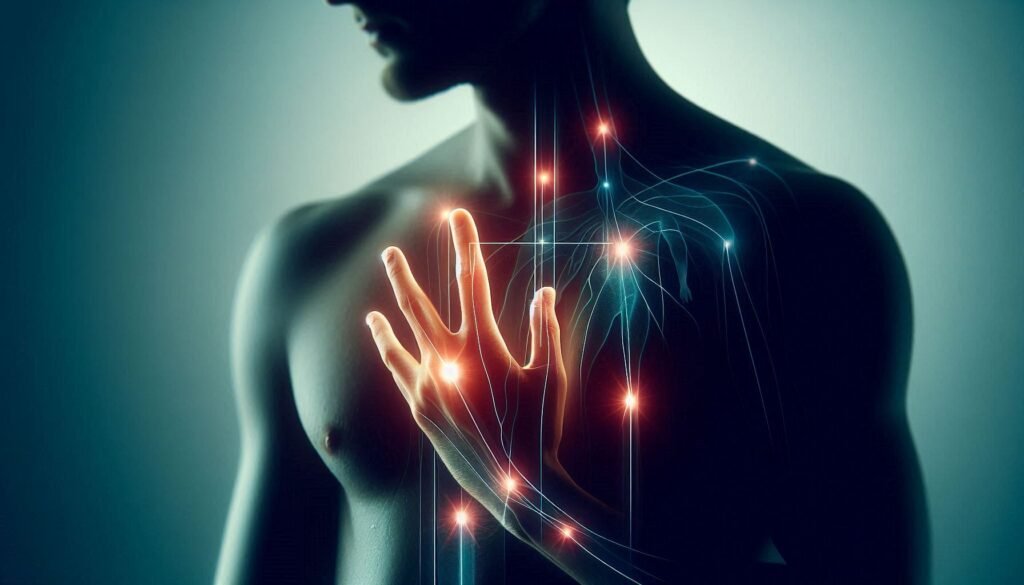When it comes to our bodies, sensations can often feel like a puzzle. Have you ever experienced a tingling feeling in your fingers or an unusual numbness in your feet? You might be facing the common experiences of numbness and paresthesia. While these terms are frequently used interchangeably, they represent distinct sensations that can arise from different underlying issues.
Understanding the difference between numbness and paresthesia is crucial for addressing symptoms effectively. Both conditions can impact daily life significantly, yet their causes and implications differ widely. This comprehensive guide will explore these distinctions in detail, helping you recognize each sensation’s unique characteristics and when to seek medical advice. Dive into this informative journey as we unravel the complexities surrounding numbness and paresthesia!

Defining Numbness and Paresthesia: Key Distinctions
Numbness is often described as a loss of sensation in a specific area of the body. This can manifest as an inability to feel touch, temperature, or pain. Commonly experienced during prolonged pressure on nerves—like sitting cross-legged for too long—it usually resolves once normal circulation resumes.
Paresthesia, on the other hand, refers to abnormal sensations such as tingling, prickling, or a “pins and needles” feeling. Unlike numbness, paresthesia does not involve complete loss of sensation but rather an altered perception of sensory input. It frequently occurs without any apparent cause.
Both conditions can arise from various sources including nerve damage or compression. While numbness might indicate issues like neuropathy or circulatory problems, paresthesia may result from nerve irritation or injury.
Recognizing these key distinctions is essential for understanding underlying health concerns and knowing when medical intervention may be necessary. Each sensation has its own implications that warrant attention based on individual circumstances.
Neurological Mechanisms: How Numbness and Paresthesia Occur
Numbness and paresthesia arise from different neurological mechanisms that impact how we perceive sensations. Numbness typically occurs when nerves become compressed or damaged, leading to a loss of feeling. This can happen due to various factors such as injury, pressure on the nerve, or conditions like diabetes.
Paresthesia is characterized by abnormal sensations—tingling, prickling, or crawling feelings—that result from nerve irritation. It often occurs when there’s temporary disruption in blood flow or electrical activity within the nervous system. Common triggers include sitting in one position for too long or experiencing anxiety.
Both conditions involve complex interactions between sensory neurons and the central nervous system. The brain interprets signals sent through these pathways differently depending on their state of health and functionality.
Understanding these mechanisms helps clarify why numbness may feel more debilitating than paresthesia at times. Recognizing the differences aids in better management of symptoms and treatment options available for each condition.
Symptom Comparison: Sensations Associated with Each Condition
Numbness and paresthesia present distinct sensations, making it essential to recognize their differences. Numbness often feels like a loss of sensation or a “dead” feeling in the affected area. It may occur suddenly and can leave individuals struggling to perceive temperature or touch accurately.
On the other hand, paresthesia introduces unusual sensations that are not typically associated with an injury or damage. People experiencing paresthesia might describe feelings as tingling, prickling, or even a crawling sensation on the skin. These manifestations often arise without a clear cause.
While numbness usually affects specific areas such as fingers, toes, or limbs, paresthesia can spread more widely across various body parts. The intensity and frequency of these sensations can also vary significantly between the two conditions.
Understanding these symptoms is crucial for effective communication with healthcare providers. Describing your experience accurately may lead to quicker diagnosis and appropriate treatment plans tailored to each condition’s unique characteristics.
Causes of Numbness vs. Triggers of Paresthesia
Numbness typically arises from nerve damage or compression. Conditions like diabetes, multiple sclerosis, and peripheral neuropathy are common culprits. Physical injuries that affect the spine or limbs can also lead to numb sensations in specific areas of the body. The underlying cause often relates to disrupted nerve signaling.
On the other hand, paresthesia is frequently triggered by temporary factors rather than chronic conditions. Sitting or lying in one position for too long may compress nerves, leading to that tingling sensation when you finally move. Stress and anxiety can exacerbate these feelings as well.
Certain medications might induce paresthesia as a side effect while vitamin deficiencies—particularly B vitamins—can contribute significantly to both symptoms but often manifest differently. Identifying whether you’re experiencing numbness or paresthesia requires understanding these distinct triggers and causes.
Recognizing how each condition develops aids in addressing them effectively. Early intervention can prevent further complications related to either symptom type.
Duration and Patterns: Temporary vs. Chronic Manifestations
Numbness and paresthesia can manifest in different durations, influencing how individuals experience these sensations. Numbness is often temporary, arising from pressure on a nerve or restricted blood flow. You may feel it after sitting or lying in one position for too long. Once the pressure is relieved, the sensation typically fades away.
Paresthesia can also be transient but may persist longer than numbness. Often described as tingling or ‘pins and needles,’ this condition might last several minutes to hours before subsiding. Situations like anxiety or hyperventilation commonly trigger such episodes.
Chronic manifestations occur when either condition persists over time. Chronic numbness could indicate underlying issues like neuropathy or multiple sclerosis, requiring further medical evaluation.
In contrast, chronic paresthesia may arise from conditions such as diabetes or vitamin deficiencies and could require ongoing management to alleviate symptoms effectively.
Impact on Daily Activities: Functional Differences
Numbness and paresthesia can significantly impact daily activities, each in unique ways. Numbness often manifests as a complete lack of sensation in specific areas, making simple tasks like gripping objects or typing challenging. Individuals may struggle with coordination, leading to potential safety concerns.
Paresthesia, on the other hand, is characterized by tingling or prickling sensations. While it may not impede movement directly, this discomfort can distract individuals during work or leisure activities. Tasks that require focus might become more difficult due to the constant awareness of these sensations.
The emotional toll also varies between the two conditions. Those experiencing numbness might feel frustration from their inability to perform everyday tasks efficiently. In contrast, people dealing with paresthesia could experience anxiety over unpredictable episodes disrupting their routines.
Understanding these functional differences helps individuals better adapt their lifestyles and seek appropriate support for managing symptoms effectively. Awareness is key to maintaining quality of life while navigating these distinct challenges.
Diagnostic Approaches: Differentiating Numbness from Paresthesia
Diagnosing the difference between numbness and paresthesia involves a comprehensive evaluation. Healthcare professionals often begin with a thorough medical history. Understanding when symptoms started, their duration, and any triggers can provide vital clues.
Physical examinations follow to assess sensory function. Doctors may test responses to touch, temperature, and vibration in affected areas. This helps determine whether nerve damage or other underlying issues contribute to the sensations.
Advanced diagnostic tools might also be employed. Nerve conduction studies measure how fast electrical signals travel through nerves. Imaging techniques like MRI scans can identify structural problems such as herniated discs or tumors pressing on nerves.
Sometimes laboratory tests are necessary to rule out conditions like diabetes or vitamin deficiencies that could cause these symptoms. Each of these strategies plays an essential role in distinguishing between numbness and paresthesia for accurate diagnosis and effective treatment planning.
Treatment Strategies: Tailored Approaches for Each Condition
For numbness, treatment often focuses on addressing the underlying cause. Physical therapy can help improve mobility and strength. Medications like corticosteroids may relieve inflammation in specific cases. If diabetes is the culprit, managing blood sugar levels is crucial.
Paresthesia treatment varies depending on its triggers. Lifestyle modifications play a significant role here. Reducing repetitive motions or avoiding certain positions can alleviate symptoms for some individuals.
Medications such as anticonvulsants or antidepressants are sometimes prescribed to manage chronic paresthesia effectively. These drugs target nerve pathways and modify abnormal sensations.
In both conditions, complementary therapies like acupuncture may offer relief for some patients by promoting nerve health and reducing discomfort. Consulting with healthcare professionals ensures that tailored strategies address individual needs and provide optimal outcomes for each condition.
When Numbness Transitions to Paresthesia: Warning Signs
Recognizing when numbness transitions to paresthesia is crucial for effective management. Numbness often presents as a loss of sensation, while paresthesia introduces abnormal sensations such as tingling or “pins and needles.” If you notice these changes, it may indicate an underlying issue that needs attention.
One warning sign to watch for is the persistence of symptoms beyond temporary relief. If numbness lasts longer than expected or occurs alongside unusual sensations, seek medical advice. This combination could signify nerve compression or damage.
Additionally, if your limbs start feeling weak or uncoordinated along with the tingling sensations, don’t ignore these signs. Weakness can suggest more serious neurological conditions requiring prompt evaluation by a healthcare professional.
Pay attention to any accompanying symptoms like pain, swelling, or redness in affected areas. These indicators may point towards circulatory issues and warrant immediate investigation to prevent further complications.
Long-term Outlook: Managing Numbness vs. Paresthesia
Understanding the long-term outlook for managing numbness and paresthesia is crucial for those affected. Both conditions can significantly impact daily life, but their management strategies differ.
Numbness often stems from underlying neurological issues or nerve damage, which may require targeted treatments such as physical therapy, medications, or lifestyle adjustments to alleviate symptoms. Regular monitoring by healthcare professionals can help track progress and adjust treatment plans accordingly.
On the other hand, paresthesia might arise from various triggers like anxiety, vitamin deficiencies, or prolonged pressure on nerves. Addressing these root causes through dietary changes, stress management techniques, and ergonomic modifications is essential for relief.
For both conditions, a proactive approach is vital. Engaging with medical professionals to develop personalized plans can lead to better outcomes. Patients should not hesitate to report any new symptoms or changes in sensation promptly. This vigilance will ensure timely interventions that cater specifically to their needs.
Understanding the differences between numbness and paresthesia empowers individuals to seek appropriate care and improve their quality of life over time. With proper management strategies in place, many find ways to live comfortably despite these sensations impacting their lives intermittently.


